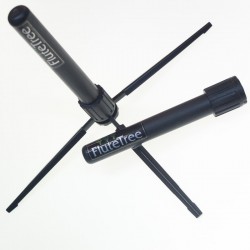Pattillo, Greg - 3 Beats for Beatbox Flute
Greg Pattillo - 3 Beats for Beatbox Flute
This piece was composed for the 2011 National Flute Association Convention High School Competition during the winter of 2010-11. It has been specifically written to bridge the gap between the traditional western flute style and the growing art form of Human Beatboxing. Videos of each movement (or Beat) have been produced and posted on youtube.com by the composer, and can be found on the youtube channel: youtube.com/ freedomworksfilms. This is a direct source for all sound, tone and technique questions, although the composer will happily answer any pertinent questions via email.
While preparing this piece, the flutist will need to learn how to make a collection of beatboxing sounds independent of the flute. At first, these sounds should be practiced without the flute in order to achieve consistency in sound, volume and control. Gradually, the performer will need to learn to make many of these sounds at the same time as playing the flute. Keep in mind that many of the beatbox sounds are frequently paired together, and practicing these pairings will also help in preparation of this piece.
Ultimately, beatboxing is an imitative art form. As such, the tone of the various beatboxing sounds needs to be matched with that of a specific instrument. Frequently, the staple sounds of a beatboxed beat are those of the high-hat cymbal, snare drum, and bass drum instruments. In writing out the notation of these beatbox sounds, much consideration was given to correlating the notation with the physical technique. However, further exploration will show that though vowel shapes in the mouth are extremely important to tone production in wind instruments, including beatboxing, the notation in this score uses only consonants. It is indeed left up to the performer to find the specific vowel shapes that work with their own mouth and throat through slow and careful practice. That being said, the following notes pages should help get you started making these sounds in a stylish way.
This piece is meant to be performed as written, with no improvisational sections. However, in working up this piece to performance standards, it is highly suggested that the performer work in small sections of 1 to 4 bars, repeating each section as an endless loop. Exploring the piece in this way will yield many great phrases that may suit ones needs as a platform to explore their own beatbox style. In this sense, improvisation is a great way to get to know the material, and riffing on the 3 Beats might be a great way to play elements of this piece with colleagues and friends in informal sessions.
Also, it is encouraged to perform this piece with a microphone, but not essential. The sounds can project well acoustically in a recital hall, but great care should be taken to
let the vocal sounds be heard in the 2nd Beat. If you plan on using a microphone, make sure you practice with it! Big plosives can overdrive a microphone in an undesirable way: you will need to temper your sounds for a microphone versus acoustic performance, and microphone placement will be an important decision to be made.
Greg Patillo (2011)
Check out the video of Project Trio's visit to Flute Tree & The Woodwind Group in 2010























